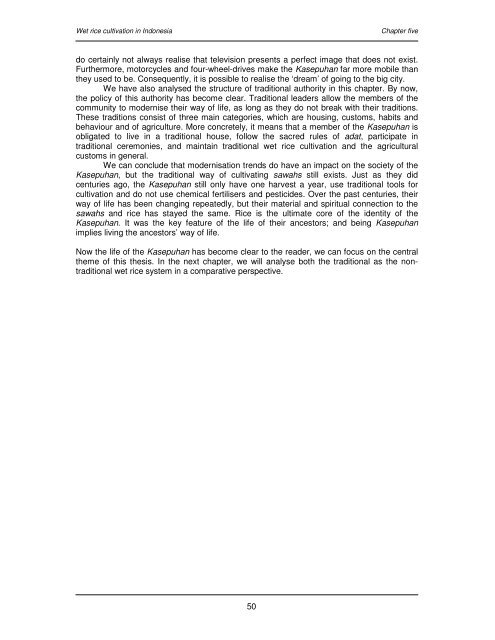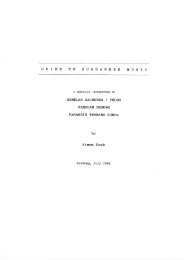Wet rice cultivation in Indonesia - Free EBooks Library
Wet rice cultivation in Indonesia - Free EBooks Library
Wet rice cultivation in Indonesia - Free EBooks Library
Create successful ePaper yourself
Turn your PDF publications into a flip-book with our unique Google optimized e-Paper software.
<strong>Wet</strong> <strong>rice</strong> <strong>cultivation</strong> <strong>in</strong> <strong>Indonesia</strong> Chapter five<br />
do certa<strong>in</strong>ly not always realise that television presents a perfect image that does not exist.<br />
Furthermore, motorcycles and four-wheel-drives make the Kasepuhan far more mobile than<br />
they used to be. Consequently, it is possible to realise the ‘dream’ of go<strong>in</strong>g to the big city.<br />
We have also analysed the structure of traditional authority <strong>in</strong> this chapter. By now,<br />
the policy of this authority has become clear. Traditional leaders allow the members of the<br />
community to modernise their way of life, as long as they do not break with their traditions.<br />
These traditions consist of three ma<strong>in</strong> categories, which are hous<strong>in</strong>g, customs, habits and<br />
behaviour and of agriculture. More concretely, it means that a member of the Kasepuhan is<br />
obligated to live <strong>in</strong> a traditional house, follow the sacred rules of adat, participate <strong>in</strong><br />
traditional ceremonies, and ma<strong>in</strong>ta<strong>in</strong> traditional wet <strong>rice</strong> <strong>cultivation</strong> and the agricultural<br />
customs <strong>in</strong> general.<br />
We can conclude that modernisation trends do have an impact on the society of the<br />
Kasepuhan, but the traditional way of cultivat<strong>in</strong>g sawahs still exists. Just as they did<br />
centuries ago, the Kasepuhan still only have one harvest a year, use traditional tools for<br />
<strong>cultivation</strong> and do not use chemical fertilisers and pesticides. Over the past centuries, their<br />
way of life has been chang<strong>in</strong>g repeatedly, but their material and spiritual connection to the<br />
sawahs and <strong>rice</strong> has stayed the same. Rice is the ultimate core of the identity of the<br />
Kasepuhan. It was the key feature of the life of their ancestors; and be<strong>in</strong>g Kasepuhan<br />
implies liv<strong>in</strong>g the ancestors’ way of life.<br />
Now the life of the Kasepuhan has become clear to the reader, we can focus on the central<br />
theme of this thesis. In the next chapter, we will analyse both the traditional as the nontraditional<br />
wet <strong>rice</strong> system <strong>in</strong> a comparative perspective.<br />
50








